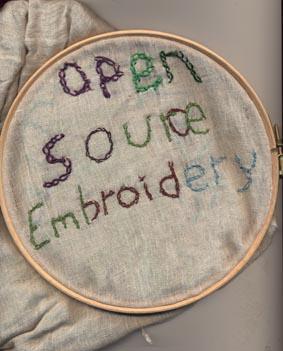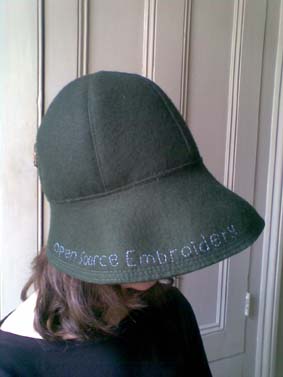|
Introduction Open Source Embroidery |
Introduction Exhibitions Html Patchwork Workshops Language Scarves Embroidered Digital Commons Links to interesting things
|


|
Open Source Embroidery, 2005 ongoing |
Introduction
Open Source Embroidery
Introduction
Exhibitions
Html Patchwork
Workshops
Language Scarves
Embroidered Digital Commons
Links to interesting things


The Open Source Embroidery project was initiated by Ele Carpenter in 2005. The project has grown to support and facilitate a range of artists practice investigating the relationship between programming for embroidery and computing. It's based on the common characteristics of needlework crafts and open source computer programming: gendered obsessive attention to detail; shared social process of development; and a transparency of process and product.
From 2010 until 2012 the project will focus on the Embroidered Digital Commons by facilitating workshops to stitch a lexicon of terms describing the idea of the digital commons.
Open Source Embroidery is a socially engaged art project developed through workshops and an email list: os-embroidery@googlegroups.com Ele's blog Ele Weekend documents the project and posts information about current workshops and exhibitions. There are also groups on Facebook and Flickr.
Background
Embroidery is constructed (mostly by women) in hundreds of tiny stitches which are visible on the front of the fabric. The system of the stitches is revealed on the back of the material. Some embroiderers seal the back of the fabric, preventing others from seeing the underlying structure of the pattern. Others leave the back open for those who want to take a peek. A few integrate the backend process into the front of the fabric. The patterns are shared amongst friends in knitting and embroidery 'ciricles'.
Software is constructed (mostly by men) in hundreds of tiny pieces of code, which form the hidden structure of the programme or interface. Open Source software allows you to look at the back of the fabric, and understand the structure of your software, modify it and distribute it. The code is shared amongst friends through online networks. However the stitches or code only make sense to those who are familiar with the language or patterns.
The same arguments about Open Source vs Free Software can be applied to embriodery. The needlework crafts also have to negotiate the principles of 'freedom' to create, modify and distribute, within the cultural and economic constraints of capitalism. The Open Source Embroidery project simply attempts to provide a social and practical way of discussing the issues and trying out the practice. Free Software, Open Source, amatuer and professional embrioderers and programmers are welcome to contribute to the project.
Open Source Embroidery pays homage to Ada Lovelace (1816-52) who helped to develop the Analytical Engine, the first idea for a universal computer, with Charles Babbage. Lovelace wrote "we may say most aptly that the Analytical Engine weaves algebraical patterns just as the Jaquard Loom weaves flowers and leaves." (Gere, 2002, p24). The Jaquard Loom (1810) was the first machine to use punched-card programming.
Ele Carpenter gave a talk as part of the Exhibition in the Lab seminar at the Centre de Cultura Contemporania de Barcelona in May 2010, her notes on Open Source Embroidery: Curatorial Facilitation of Material Networks can be viewed here.